Common menu bar links
Breadcrumb Trail
ARCHIVED - Statistics Canada - Report
 This page has been archived.
This page has been archived.
Archived Content
Information identified as archived on the Web is for reference, research or recordkeeping purposes. It has not been altered or updated after the date of archiving. Web pages that are archived on the Web are not subject to the Government of Canada Web Standards. As per the Communications Policy of the Government of Canada, you can request alternate formats on the "Contact Us" page.
Minister's Message

Last year, Canada was the last country to fall into the global recession. Today, our economy is beginning to emerge in the strongest position of any advanced country in the world. Investment and key stimulus measures as part of Year 1 of Canada's Economic Action Plan (www.actionplan.gc.ca) provided continued results and helped set Canada apart from its G-8 counterparts in terms of economic strength.
In 2009/2010, Industry Canada worked quickly with its Portfolio Partners to deliver timely and targeted stimulus initiatives. Composed of Industry Canada and 10 other agencies, Crown corporations and quasi-judicial bodies, the Portfolio helps the department to build a more productive and competitive economy.
As part of the Industry Portfolio, Statistics Canada continued to be a trusted source of statistical information to help Canadians better understand their country—its population, resources, economy, society and culture. The organization provided data and analyses to meet the statistical needs of federal, provincial and territorial governments, businesses, unions and not-for-profit organizations.
Moving forward, Industry Canada will continue to ensure that the jobs and industries of the future are created right here in Canada. We will follow through on delivering existing stimulus plans and continue to support government priorities. This means ensuring that we have the right conditions and regulatory frameworks in place to encourage investment in Canada, increasing support for R&D to improve Canada's long-term competitiveness and developing a digital economy.
I will work with the Industry Portfolio Partners, the private sector and other governments to enhance Canada's productivity and create the foundation for strong, sustainable and balanced growth.
It is my pleasure to present this year's Departmental Performance Report for Statistics Canada.
The original version was signed by Tony Clement, Minister of Industry
Chief Statistician's Message
I am pleased to present Statistics Canada's Departmental Performance Report.
As Chief Statistician of Canada, my goal is to ensure that Canadians have access to a trusted source of information. This is a key component in the effective governance of the country. Trust can only be kept if the data Statistics Canada produces are consistent with the needs of the country and well representative of the world they seek to describe. Statistics Canada strives to achieve this goal efficiently, producing relevant, high-quality information at the lowest possible cost.
I am happy to report that Statistics Canada continues to make progress in achieving its strategic outcomes:
- Information produced by Statistics Canada is relevant and widely accessed. Users downloaded 31.6 million data series from the CANSIM online database in 2009/2010, up by 4.3 million from the previous year. In addition, 9,294 media citations in newspapers, on national radio and television networks and online media services facilitated broad public access to data.
- The quality of statistical outputs has been maintained, as the high standard for sampling accuracy continues to be met and even exceeded for major statistical outputs.
- Statistics Canada is an efficient organization. The Treasury Board ranked Statistics Canada among the best-managed departments of similar size in the federal government.
However, to continually make progress, we must also acknowledge our challenges. After increasing by 14% in 2008/2009, visits to the Statistics Canada website decreased by 4% in 2009/2010. Although annual fluctuations are normal, owing in large part to the five-year census cycle, Statistics Canada continues to explore ways to improve the website and use new tools to broaden its reach to Canadians. As well, charging for data continues to be viewed as a barrier to access. Clients also indicated that data gaps remain in particular statistical sectors. To maintain the quality and utility of our statistics, we must reallocate resources from programs that are less relevant to those that address emerging information needs.
Statistics Canada is committed to maintaining an efficient, world class statistical system. I invite readers to benefit from the work of their national statistical bureau by visiting our website at www.statcan.gc.ca. Your feedback is most welcome.
The original version was signed by Wayne R. Smith, Acting Chief Statistician of Canada.
Section 1 Agency Overview
1.1 Summary Information
Raison d'être
The Government of Canada established Statistics Canada to ensure that Canadians have access to a trusted source of statistics related to Canada. Access to trusted information is fundamental in an open, democratic society to support decision-making by people and their elected representatives.
The statistics produced by Statistics Canada inform national policy and support evidence-based program management. A large portion of Statistics Canada's activities is devoted to meeting the needs of federal, provincial and territorial government policy departments, and to continually measuring Canadian socioeconomic dynamics and emerging trends.
Mandate
Statistics Canada's mandate derives primarily from the Statistics Act, R.S.C. 1970. The Act requires that the agency collect, compile, analyse and publish statistical information on the economic, social and general conditions of the country and its people. This mandate covers a broad range of statutory requirements and instruments, as well as contractual obligations, for which Statistics Canada must produce information.
The Statistics Act requires Statistics Canada to conduct a Census of Population and a Census of Agriculture every fifth year. The Act also confers substantial powers on the agency to request information for statistical purposes through surveys of businesses and households.
Statistics Canada is also mandated to co-ordinate and lead the national statistical system, specifically to prevent duplication in the information collected by government. Statistics Canada can also, by law, access all administrative records (e.g., tax data, customs declarations, and birth and death records), enabling it to reduce reporting burden on business and individual respondents, and to reduce redundant data-collection efforts across government. Statistics Canada is considered a leader among statistical agencies in reducing reporting burden by using administrative data. Partnerships and cost-recovery arrangements with other federal departments, other jurisdictions and external organizations play a large role in reducing reporting burden.
Strategic Outcome and Program Activity Architecture
Statistics Canada's strategic outcome is that Canadians have access to objective, high-quality, non-partisan statistics, statistical products, services and analyses on Canada, which fulfill legal requirements, are relevant to policy formulation and decision makers, and are responsive to emerging issues.
To meet this strategic outcome, Statistics Canada has identified two expected results. The first expected result focuses on Canadians' access to statistical information. The second expected result focuses on ensuring trust in the information provided. Key factors to ensure that the statistical information produced by Statistics Canada can be trusted are relevance and quality of data. In addition, the extent to which Statistics Canada is able to achieve its strategic outcome depends on its ability to optimize its management and operations through organizational efficiency.
Statistics Canada's program activity architecture is shown in Figure 1. The strategic outcome and expected results, as well as all the performance indicators used in this report, are listed in Figure 2. Performance highlights are summarized in Table 3. Performance details by program activity are found in Section 2.

[D]
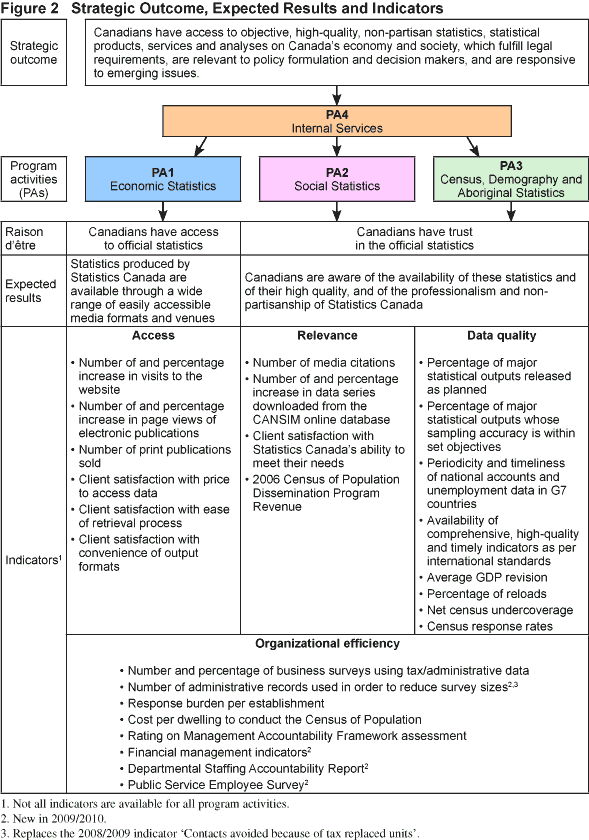
[D]
1.2 Performance Summary
Statistics Canada's statistical program is funded through direct parliamentary appropriations and cost-recovery activities. In recent years, the agency's 'respendable' cost-recovery revenues—revenues Statistics Canada is authorized to spend on the activity that generated them—have added more than $100 million to its total resources. A large portion of these respendable revenues is from federal departments to fund specific statistical projects.
| Planned spending | Total authorities | Actual spending |
|---|---|---|
| 454,391 | 537,221 | 509,093 |
| 1. Totals may differ within and between tables because of rounding. Amounts shown are net of respendable revenue. | ||
| Planned | Actual | Difference |
|---|---|---|
| 5,567 | 5,545 | 22 |
Table 3 Performance Highlights
| Performance Indicators | Targets/benchmarks | 2009/2010 performance summary1 |
|---|---|---|
| Indicators of access | ||
| Number of visits to the Statistics Canada website | Annual increase in visits exceeds 5% | Not met – Visits to the website decreased by 4.2%2 |
| Client satisfaction with price to access data | Rating of 4 on a scale of 5 | Somewhat met – Client satisfaction rating was 3.6 for economic statistics and 3.3 for social statistics |
| Indicators of relevance | ||
| Number of data series downloaded from the CANSIM online database | Annual increase in downloaded series exceeds 5% | Exceeded – Downloaded series increased 23.2% for economic statistics, 13.4% for social statistics |
| Clients' satisfaction with Statistics Canada's ability to meet their needs | Rating of 4 on a scale of 5 | Mostly met – Client satisfaction rating was 4.0 for economic statistics and 3.9 for social statistics |
| Number of media citations | Many | Met all – There were 9,294 media citations |
| Indicator of quality | ||
| Percentage of statistical outputs that meet set levels of sampling accuracy | 95% of major statistical outputs meet set levels of sampling accuracy | Exceeded – 96.0% for economic statistics and 99.7% for social statistics |
| Indicators of organizational efficiency | ||
| Rating on 21 areas of management, as defined in the federal Management Accountability Framework | Obtain rating of 'strong' or 'acceptable' in most areas of management | Met all – Rated 'strong' or 'acceptable' in all but one area of management |
| Departmental Staffing Accountability Report (DSAR) | Improve on results from the 2008 DSAR | Exceeded – Overall rating improved to 'strong' |
| Public Service Employee Survey 2008 | Rank among the best in comparison with other federal government departments (response rates and overall results) | Met all – Response rates well above Public Service average; job satisfaction at or above other federal departments |
| Financial reporting to Policy Committee | Monthly | Met all – All financial reports delivered as planned |
| 1. The scale used for assigning the 2009/2010 performance status is detailed in Figure 3. 2. After increasing by 14.4% in 2008/2009, visits to the Statistics Canada website decreased by 4.2% in 2009/2010 to just over 16.7 million visits for the year. Annual fluctuations are expected, the result of factors such as the number and types of releases and the social and economic situation in the country—the lowest numbers are posted at the end of the five-year census cycle. In 2009/2010, Statistics Canada continued to explore ways in which the website could be improved, and undertook new initiatives such as using social-networking tools to broaden its reach to Canadians. |
||
Table 3 Performance Highlights (concluded)
| Program activity | Expected results | 2009/20101 | Alignment to Government of Canada outcomes | ||||
|---|---|---|---|---|---|---|---|
| 2008/2009 Actual spending | Main estimates | Planned spending | Total authorities | Actual spending | |||
| $ thousands | |||||||
| Economic Statistics | Statistics produced by Statistics Canada are available through a wide range of easily accessible media formats and venues2 Canadians are aware of the availability of these statistics and of their high quality, and of the professionalism and non-partisanship of Statistics Canada.3 |
192,605 | 165,571 | 165,571 | 200,298 | 190,129 | A transparent, accountable and responsive federal government |
| Social Statistics | 128,249 | 132,585 | 132,585 | 144,751 | 136,495 | ||
| Census, Demography and Aboriginal Statistics | 85,398 | 78,669 | 78,669 | 100,325 | 93,146 | ||
| Internal Services | 91,109 | 77,566 | 77,566 | 91,847 | 89,323 | ||
| Total | 497,361 | 454,391 | 454,391 | 537,221 | 509,093 | ||
| 1. Totals may differ within and between tables because of rounding. Amounts shown are net of respendable revenue. 2. Expected result 1 focuses on access to statistical information by Canadians. 3. Expected result 2 contributes to ensuring trust in the information provided by Statistics Canada. |
|||||||
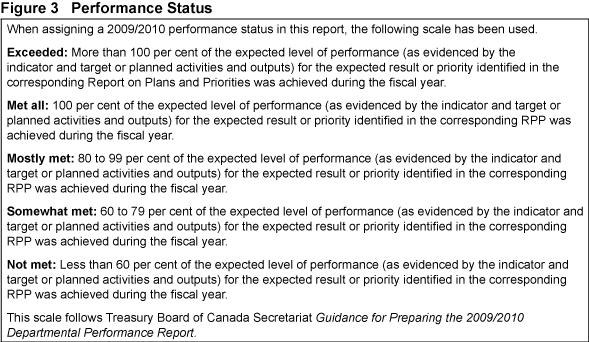
[D]
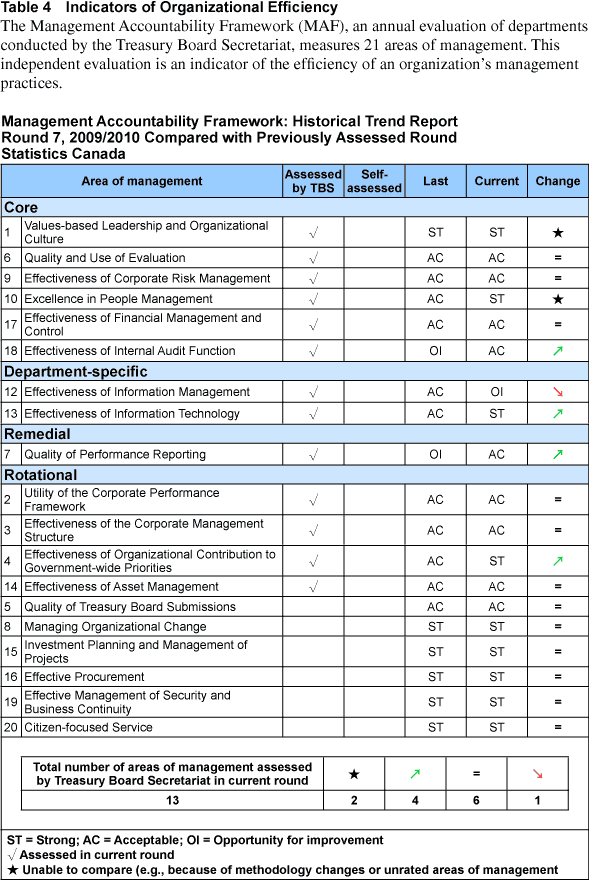
[D]
Performance Results
Overall, Statistics Canada has obtained solid evaluation results in each of the performance rounds.
The 2009/2010 MAF Round 7 results indicate that the management efficiency of Statistics Canada is high and continues to improve. Highlights of the assessment include the following:
- 9 of the 21 areas of management are rated 'strong'
- 9 of the 21 areas of management are rated 'acceptable'
- assessment ratings improved in 4 areas of management in Round 7 over Round 6.
One area of focus is the effectiveness of the agency's information management. Here the MAF score went from 'acceptable' to 'opportunity for improvement'. Change has already taken place. The agency is developing a formal information management strategy and has established a departmental Information Management Committee to provide oversight.
Contribution of Priorities to Strategic Outcome
To support decision-making by Canadians and their elected representatives, Statistics Canada remained committed to providing access to a trusted source of information. The main accomplishments in 2009/2010 were to ensure that our information was more easily accessible, that our economic and social statistics remained strong in relevance and quality, that our 2011 Census preparations were completed, and that our operations became more efficient.
| Operational priorities | Type1 | Performance status | Link to program activity | Contribution to the strategic outcome2 |
|---|---|---|---|---|
| Historical Revision of the Canadian National Accounts An historical revision of the Canadian National Accounts was conducted to bring them in line with updated international standards. The project teams and governance are in place and on track to deliver the first phase in 2012, making Canada one of the first three countries in the world to implement the new standard. |
New | Met all | Economic Statistics | Quality |
| Balance of Payments Redesign A redesign of the Balance of Payments (Phase III) to update surveys of international financial transactions to meet revised international standards. In 2009/2010, Balance of Payments survey content was revised for the four principal annual financial surveys, resulting in a more coherent set of questionnaires. A systems prototype has been delivered, which features additional functionality for accessing historical data. Preliminary research on sampling methods has been delivered and is under review. |
New | Met all | Economic Statistics | Quality |
| General Business Panel Survey and Integrated Business Database The objective of the General Business Panel Survey and Integrated Business Database is to track business strategies and link them with businesses' performance over time. Pilot Survey Data—Together with the project sponsors, Statistics Canada determined the content for an integrated survey of business strategies, innovation and global value chains. The pilot survey was collected from January to March 2010, and achieved a response rate of over 60%. Business Performance Data—Qualitative survey data for 2009 has been processed, and several databases were linked to provide quantitative data on firm characteristics and business performance from 2000 to 2006. Some variables from the Business Register have been included from 2007 to 2009 to allow the linkage of pilot survey data. This provides a unique integrated database on Canadian businesses that can support analytical research. Researcher Assessment—Under this initiative, Statistics Canada facilitated access to this new database for designated policy researchers so they could to assess the utility of such data for policy research. |
Previously committed | Mostly met | Economic Statistics | Access |
| Services Producer Price Indexes Statistics Canada published three new services producer price indexes in the last year: the Wholesale Price Index, the For-hire Motor Carriers of Freight Index (covering trucking services) and the Commercial Rents Price Index. These and other new indexes are part of an initiative to improve coverage of service prices. Significant progress on the Retail Services Price Index and the Commercial and Industrial Machinery and Equipment Rental and Leasing Price Index was also made; these new products will be launched in October 2010. Development of other price indexes continues in the areas of banking, insurance, telecommunications and transportation. |
Ongoing | Met all | Economic Statistics | Relevance |
| Canadian Health Measures Survey The Canadian Health Measures Survey (CHMS) involves collection of key health information—via direct physical measurement—and the creation of national baseline health data. Data for the inaugural CHMS cycle were disseminated in January 2010 with the release of household and clinic data, and followed in March 2010 with the release of laboratory data (excluding environmental measures). Each release included microdata files, summary tables, a user guide, derived variables, a data dictionary and articles published in the Statistics Canada journal Health Reports. CHMS microdata files are available in Statistics Canada Research Data Centres and the CHMS share files have been provided to federal partners— Health Canada and the Public Health Agency of Canada. The second cycle of the CHMS began collection in August 2009 with essentially the same content. |
Ongoing | Met all | Social Statistics | Access |
|
Household Survey Redesign The household survey redesign will address challenges to the household survey program, in particular rising costs, declining response rates, changing user needs and a need for flexible options for respondents. This second year of the multi-year project saw the development of requirements and the start of integration of processes and systems, such as
|
Previously committed | Mostly met | Social Statistics | Quality and organizational efficiency |
| Crime Severity Index The new Crime Severity Index provides a more meaningful indicator of the change in police-reported crime from year to year. It also makes crime statistics more comparable at the provincial, territorial and municipal levels by taking into account the relative seriousness of each offence. The index was released in May 2009. Canada is considered among the leaders in the international community in the measurement of police-reported crime, owing to both our national coverage for incident-based crime microdata and the new Crime Severity Index. |
New | Met all | Social Statistics | Relevance |
| 2011 Census of Population Preparation for the 2011 Census of Population continued as planned, including an integrated Census Test conducted in the summer of 2009. The objectives of the test were to fully exercise systems, procedures and processes, as well as enhancements aimed at improving areas that were problematic in 2006 and to validate major changes. The first major initiative being implemented for the 2011 Census is to encourage online responses by mailing a letter instead of a questionnaire package to 60% of all dwellings. The second major initiative is a web-based system, enabling staff in the field to communicate with head office to better manage and monitor the follow-up required with Canadian householders who do not complete a census questionnaire promptly. |
Previously committed | Met all | Census, Demography and Aboriginal Statistics | Quality and organizational efficiency |
| 2011 Census of Agriculture The Census of Agriculture, along with the Census of Population, participated in the May 2009 Census Test. The test showed that proposed content changes to the questionnaire performed well with respondents. The test confirmed that, technically, the new Census of Agriculture collection methodology of a full mail-out is feasible. The mailing list performed well, as did the procedures for drop-off and return registration with Canada Post Corporation. The test clearly showed the positive impact on response rates for the Census of Agriculture owing to being coupled with the Census of Population: response rates were 10 percentage points higher in overlap areas than in areas where only the Census of Agriculture was tested. Systems development and testing, along with frame enhancement proceeded as planned, in order to position the Census of Agriculture for the Census in 2011. |
Previously committed | Met all | Census, Demography and Aboriginal Statistics | Quality and organizational efficiency |
| Management priorities | Type1 | Performance status | Link to program activity | Contribution to the strategic outcome2 |
| Collection Business Architecture The Collection Business Architecture initiative is designed to modernize and streamline Statistics Canada's data-collection processes. Through greater use of the excess space and infrastructure now available, business surveys previously collected from Ottawa were successfully conducted in regional offices located across Canada. Two pilots involving approximately 75 business surveys resulted in higher response rates than in previous years and the same level of data quality. Challenges were encountered this year, as we progressed through these initiatives: workloads increased for many staff members, additional training was delivered and change management processes were implemented. As a result, 80% of the mandated $2 million in financial efficiencies were achieved one year ahead of the target delivery date of April 1, 2011. |
New | Met all | Internal services | Organizational efficiency |
Public Service Renewal
|
New | Exceeded | Internal Services | Organizational efficiency |
| Internal Audit The objective was to strengthen the agency's internal audit function in accordance with Treasury Board policy. During the year, the internal audit function strengthened its professional practices and completed a full implementation of the Departmental Audit Committee. The renewed internal audit function is the cornerstone of assurance to the Chief Statistician and senior management on governance, risk management and internal control. Experienced internal auditors were recruited, a new risk-based audit plan was put in place, and greater coverage of high-risk areas was implemented. These are all elements of a strong internal audit function. The early implementation of a quality assurance and improvement program is a sign of the agency's strong internal audit governance framework. |
New | Met all | Internal Services | Organizational efficiency |
| 1. Type is defined as follows: previously committed to—committed to in the first or second fiscal year before the subject year of the report; ongoing—committed to at least three fiscal years before the subject year of the report; and new—newly committed to in the reporting year of the RPP or DPR. 2. These items are linked to the priorities elaborated in the agency's Corporate Business Plan. |
||||
Risk Analysis
Risk management is the foundation of all activities undertaken by the organization.
Statistics Canada achieves its strategic objective of efficiently providing access to relevant and quality data through the Performance Management Framework (see Figure 4). This framework is built on a foundation of risk management. At the heart of the framework and the department's mandate are access, relevance, quality and organizational efficiency. All activities are aligned with these objectives. The annual long-term planning process provides a means to optimize the allocation of resources towards the achievement of corporate objectives.
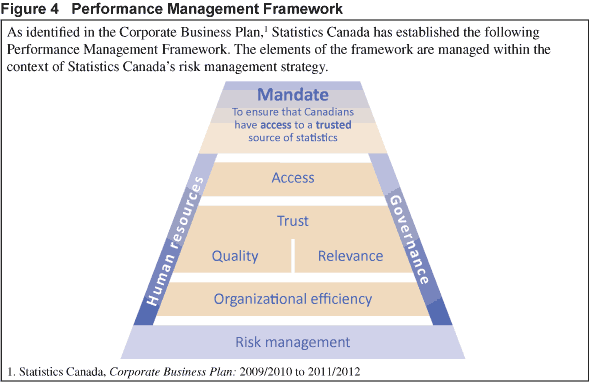
[D]
In this context, risk is defined as any event that may prevent the organization from achieving its objectives.
To manage risks, Statistics Canada has developed this model. First, managers and subject-matter experts identify and categorize all risks related to the four corporate objectives. They then measure the level of inherent risk for each identified risk. Inherent risk is the risk that is linked to an activity by the nature of the activity and by the very fact that the organization performs this activity. They then evaluate the effectiveness of existing mitigation strategies that have been in place over a number of years, based on the experience and judgment of program managers and Statistics Canada's senior management. What is left is the residual risk. This is what Statistics Canada is most concerned with, and needs to manage continually. As well, external risk factors are taken into consideration at the corporate level as part of this exercise.
To fully measure the residual risk, program managers provide their expert assessment of the probability of the risk materializing and the subsequent impact. They base their assessments on both quantitative information and subjective assessments derived from their experience. Experts are also asked to estimate the composite level of residual risk, or risk exposure, by combining the probability of the risk materializing and the subsequent impact. The risk exposure is classified as high, medium or low.
For the most important risks, as determined by the experts, the following information is also collected: the estimated cost of implementing further risk-mitigation strategies, and expert assessment of whether these strategies would be worth the cost.
The risk information thus gathered is used by program managers to help determine if proposals should be part of Statistics Canada's annual long-term planning process. That process, which begins each year in October and concludes in February, has a three- to five-year planning horizon. As part of the annual long-term planning process, the risks in the Risk Register are prioritized. An evaluation of the cost and benefit of various proposals to further mitigate the most important residual risks is completed. The long-term planning process therefore assesses return on investment in risk management activities towards the achievement of the corporate objectives. In some cases, mitigation of important risks may become a priority and be presented in the Report on Plans and Priorities. At the end of the period, the Departmental Performance Report provides an assessment of how effectively such risk mitigation contributes to the agency's priorities.
Applying this risk management model, the status of the key risks identified in the 2009/2010 Report on Plans and Priorities can be assessed. The risks identified were security of data supply, usefulness of outputs, and challenges of running a large and complex organization.
To mitigate these risks, Statistics Canada undertook a number of activities. First, the agency launched an initiative to modernize collection practices to improve efficiency and to address security of data supply. To make its outputs more useful, Statistics Canada made investments in many surveys, including surveys relating to the economy, the environment, health, and the administration of justice. In addition, the agency extended the coverage of producer price indexes in service industries—an investment to improve the measurement of real output and productivity in the Canadian economy. Statistics Canada has also revised the Canadian National Accounts to bring them in line with updated international standards.
More broadly, the management challenges of running such a complex organization have been well mitigated by the agency's strong governance structure and practices, as well as its risk management strategy, advisory committees, planning process, user feedback and audits and evaluations.
Finally, Statistics Canada must be prepared to deal with events when risks materialize. To do this, Statistics Canada has a business continuity plan in place. For any and all other risks, a strong governance structure is in place. New issues are quickly brought to the attention of Policy Committee, the agency's most senior executive committee, for immediate action. Statistics Canada's Risk Management Committee oversees development of the risk management model, and guides and monitors the implementation of the model.
This simple yet highly effective risk management model provides the following benefits:
- It provides Statistics Canada with a comprehensive picture of every major risk through a Risk Register. The Risk Register identifies significant risks by source and by program for the entire agency.
- It enables creation of Statistics Canada's Corporate Risk Profile in a consistent manner.
- It provides concrete quantitative risk-assessment data, enabling consistent, integrated decision-making based on solid facts.
- It enables optimization of benefits at the lowest possible cost by taking into account the costs and benefits of potential mitigation strategies.
- It provides the tools to constantly update and anticipate risks and plan on how to deal with them.
Expenditure Profile
Figure 5 shows the seven-year trend of Statistics Canada's total spending and spending net of respendable revenue. The first year, 2006/2007, marks the year of the 2006 Census; the last year, 2012/2013, will be the year after the 2011 Census.
Figure 5 Spending Trends
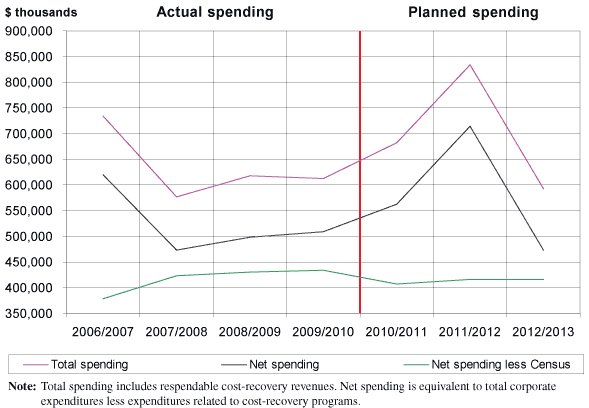
[D]
As shown in Figure 5, total and net spending will rise in 2010/2011, peak in 2011/2012 when the 2011 Census of Population and 2011 Census of Agriculture are conducted, and drop sharply in 2012/2013 as these activities begin to wind down. This pattern is typical for the agency, a function of the cycle of the Census program, as demonstrated by the declining spending from 2006/2007 to 2007/2008.
In 2009/2010, net spending increased slightly over 2008/2009, owing to preparations for the 2011 Census.
Variances by Source
Table 6 provides a more detailed breakdown of Statistics Canada's spending for the most recent fiscal years.
| Program activity | 2007/2008 | 2008/2009 | 2009/2010 | |||
|---|---|---|---|---|---|---|
| Actual spending | Actual spending | Main estimates | Planned spending | Total authorities | Actual spending | |
| $ thousands | ||||||
| Economic Statistics | ||||||
| Net spending | 185,082 | 192,605 | 165,571 | 165,571 | 200,298 | 190,129 |
| Add respendable revenue | 18,914 | 22,282 | 24,497 | 24,497 | 24,497 | 24,808 |
| Total spending | 203,996 | 214,887 | 190,068 | 190,068 | 224,795 | 214,937 |
| Social Statistics | ||||||
| Net spending | 130,622 | 128,249 | 132,585 | 132,585 | 144,751 | 136,495 |
| Add respendable revenue | 55,696 | 70,354 | 59,872 | 59,872 | 59,872 | 50,788 |
| Total spending | 186,318 | 198,603 | 192,457 | 192,457 | 204,623 | 187,283 |
| Census, Demography and Aboriginal Statistics | ||||||
| Net spending | 75,155 | 85,398 | 78,669 | 78,669 | 100,325 | 93,146 |
| Add respendable revenue | 24,847 | 23,413 | 29,439 | 29,439 | 29,439 | 23,659 |
| Total spending | 100,002 | 108,811 | 108,108 | 108,108 | 129,764 | 116,805 |
| Internal Services | ||||||
| Net spending | 83,172 | 91,109 | 77,566 | 77,566 | 91,847 | 89,323 |
| Add respendable revenue | 3,698 | 3,794 | 6,192 | 6,192 | 6,192 | 3,691 |
| Total spending | 86,870 | 94,903 | 83,758 | 83,758 | 98,039 | 93,014 |
| Total Statistics Canada | ||||||
| Net spending | 474,031 | 497,361 | 454,391 | 454,391 | 537,221 | 509,093 |
| Add respendable revenue | 103,155 | 119,843 | 120,000 | 120,000 | 120,000 | 102,946 |
| Total spending | 577,186 | 617,204 | 574,391 | 574,391 | 657,221 | 612,039 |
Respendable revenue adds more than $100 million per year to Statistics Canada's budget, enabling production of a wide variety of statistics used by other federal departments to run their programs effectively. Provincial governments, private companies and other entities also use these statistics extensively.
Statistics Canada relies heavily on other government departments to provide this much-needed source of funding, as Figure 6 demonstrates.
Figure 6 Respendable Revenues, by Source
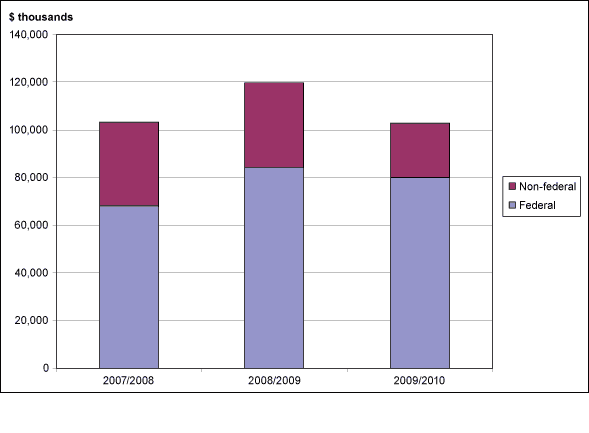
[D]
Canada's Economic Action Plan Initiatives
Announced in Budget 2009, Canada's Economic Action Plan (CEAP) provided Statistics Canada with $2.9 million to extend the Canadian Environmental Sustainability Indicators program and $0.2 million to enhance federal public service student employment. The $3.1-million total includes contributions to employee benefit plans (EBP).
The Canadian Environmental Sustainability Indicators is a joint initiative with Environment Canada (the lead department) and Health Canada. In 2009/2010, Statistics Canada committed to deliver survey results and underlying microdata for the Households and the Environment Survey 2007, the Agricultural Water Use Survey 2006, the Industrial Water Survey 2007, and the Survey of Drinking Water Plant 2007. In addition, Statistics Canada undertook to collect the data for the Households and the Environment Survey 2009.
Performance status: Met all — all CEAP deliverables were completed.
Voted and Statutory Items
Table 7 shows the way in which Parliament approved Statistics Canada's resources, the changes in resources derived from supplementary estimates and other authorities, and how the funds were spent.
| Voted (number) or statutory (S) item | Truncated vote or statutory wording | 2009/20101 | |||
|---|---|---|---|---|---|
| Main estimates | Planned spending | Total authorities | Actual spending | ||
| $ thousands | |||||
| 95 | Operating expenditures | 391,910 | 391,910 | 460,237 | 432,109 |
| (S) | Contributions to employee benefit plans | 62,481 | 62,481 | 76,984 | 76,984 |
| Total | 454,391 | 454,391 | 537,221 | 509,093 | |
| 1. Totals may differ within and between tables because of rounding. Amounts shown are net of respendable revenue. | |||||
A significant portion of the difference between planned and actual spending is due to collective agreement settlements within the fiscal year. In-year approvals of funding for the Canadian Health Measures Survey and the 2011 Census of Agriculture also increased spending authority.
